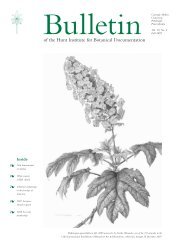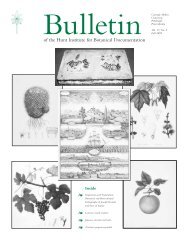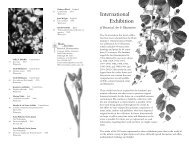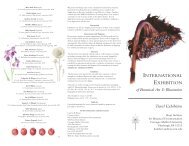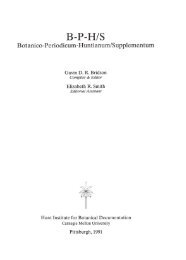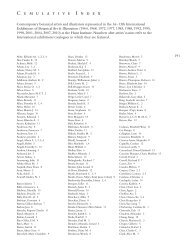Bulletin - Hunt Institute for Botanical Documentation - Carnegie ...
Bulletin - Hunt Institute for Botanical Documentation - Carnegie ...
Bulletin - Hunt Institute for Botanical Documentation - Carnegie ...
You also want an ePaper? Increase the reach of your titles
YUMPU automatically turns print PDFs into web optimized ePapers that Google loves.
In Memoriam<br />
Joseph Calcutta (1911–2001)<br />
Following a long employment with the <strong>Hunt</strong> family, Joseph<br />
Calcutta was the operations manager at the <strong>Institute</strong> from<br />
1967 until his retirement in 1978, after which he continued as<br />
operations consultant. He is survived by his wife, Margaret<br />
Ann, and five children, Sr. Margaret Ann, Joseph, James, Gerard<br />
and Francis.<br />
I had been at the <strong>Institute</strong> <strong>for</strong> a little over a year when I met<br />
Joe in 1999 during an exhibition. When he learned that I was<br />
a new employee, he was eager to take me on a proper tour<br />
of the Reading Room, the elegant space fashioned by Mrs.<br />
<strong>Hunt</strong> after her library. This gorgeous room is, frankly, a little<br />
intimidating. Like the decorative arts collection at any museum,<br />
it invites respectful gazing from behind the safety of glass doors.<br />
I had yet to muster the courage to tread upon the Savonnerie<br />
rugs woven on 17th-century looms in Aubusson. The echo of<br />
my shoes clicking across the teakwood parquet imported from<br />
Thailand was enough to discourage any attempts at exploration.<br />
Besides, there were manuscripts to edit.<br />
That night, with the glass doors flung wide, Joe and I glided<br />
across the threshold, the barriers of class and time disappearing<br />
like mist. Joe recounted stories at each piece of furniture. There<br />
was the chandelier Mrs. <strong>Hunt</strong> spotted from the car in the window<br />
of an antique store on Fifth Avenue. The portraits of the children<br />
and of Mrs. <strong>Hunt</strong> gave him pause as he remembered. For Joe,<br />
who had seen the originals, even these replicas held a lifetime<br />
of memories. I wish I had been prepared to take notes.<br />
Since then, I have read the letters, shuffled through the receipts,<br />
and spread out the building plans. I have sorted myth from reality<br />
into separate files. I’m no longer reluctant to enter the room.<br />
Maybe he did see the past through Mrs. <strong>Hunt</strong>’s rose-colored<br />
mirror, but it was a better story when Joe told it.<br />
Richard Carroll, self portrait.<br />
10 Bull. <strong>Hunt</strong> Inst. Bot. Doc. 13(2), Fall 2001<br />
— Scarlett T. Townsend<br />
Gary Arnold, Joseph Calcutta, and Alfred <strong>Hunt</strong> at the 2nd<br />
International preview reception in 1972. The portrait of Mrs.<br />
<strong>Hunt</strong> by Antonio Ortiz Echagüe is in the background.<br />
Richard Carroll (1931–2001)<br />
After spending 20 years as an art director and television<br />
producer at Young & Rubicam in New York and Detroit,<br />
Richard Carroll began freelancing in advertising art in<br />
1974. He turned to fine art in 1987, mainly painting hyperrealistic<br />
subjects in egg tempera. He held his first exhibition<br />
in 1989 at the Alexander Milliken Art Gallery, New York.<br />
In the following years his work was included in several group<br />
exhibitions including our 7th International Exhibition of <strong>Botanical</strong><br />
Art & Illustration in 1992 and the Dr. Shirley Sherwood<br />
collection in London. His work was the inspiration <strong>for</strong> our<br />
fall 2000 exhibition, Gifts of Winter, which featured six of his<br />
paintings in egg tempera. In an introductory essay to his work<br />
in Gifts of Winter, Carroll described his method: “The shape,<br />
edge detail, surface texture and <strong>for</strong>m as revealed in a strong,<br />
single source light are the considerations that attract me to<br />
choose the inventory from which my compositions are derived.<br />
… Egg tempera is unique in its qualities, and I know of no<br />
other medium that allows the versatility in painting subjects<br />
of this kind.” His work is also in many private collections in<br />
the United States, Canada and Europe.<br />
— (from White and Bruno, Gifts of Winter, Pittsburgh,<br />
2000)



